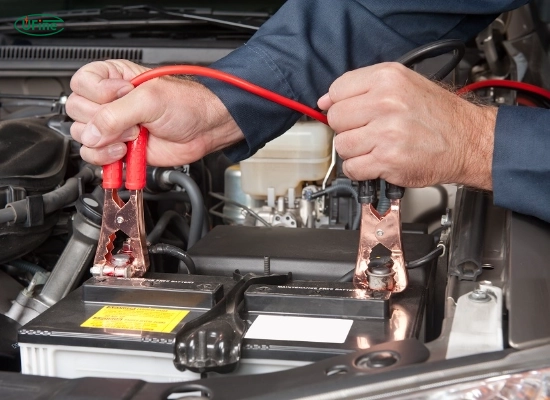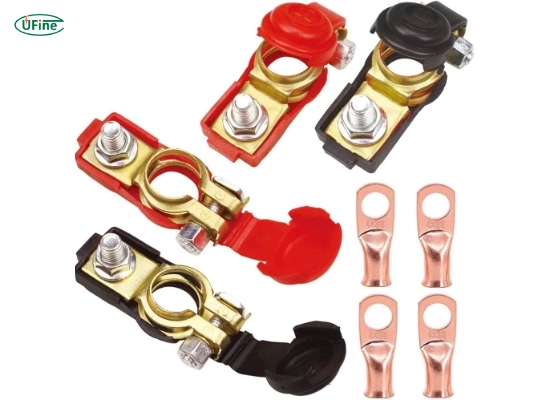Battery terminal clamps are crucial components in any vehicle or machinery that relies on a battery for power. These small yet significant parts ensure a secure and efficient connection between the battery and the electrical system. This comprehensive guide will delve into everything you need to know about battery terminal clamps, from their types and materials to installation and maintenance.
Part 1. What are battery terminal clamps?
Battery terminal clamps are devices used to connect the battery cables to the battery terminals. They play a vital role in ensuring the electrical current flows smoothly from the battery to the vehicle’s electrical system. With proper clamps, the connection can stay stable, leading to good performance or even failure of the electrical system.
Part 2. Types of battery terminal clamps
1. Top Post Clamps
Top post clamps are the most common type found in traditional automotive batteries. They are versatile and can accommodate various cable attachments. These clamps are typically made of lead or lead alloys and designed to fit over the battery’s top posts.
2. Side Post Clamps
Manufacturers typically use side post clamps in newer vehicles. They save space and provide a secure connection but may not be as versatile as top post clamps. Manufacturers usually make these clamps from steel or brass and design them to screw into the side of the battery.
3. Universal Clamps
Universal clamps can work as both top and side post clamps, offering installation flexibility. They are ideal for those who want a versatile solution that fits different types of vehicles.
4. Marine Clamps
Engineers design marine clamps for use in boats and other marine applications. They are made from corrosion-resistant materials like brass or stainless steel to withstand harsh conditions. These clamps often feature a wing nut for easy tightening and loosening.
5. Military Clamps
Military clamps are heavy-duty clamps designed for high-performance applications. Manufacturers often use high-quality materials like copper or brass and build them to withstand extreme conditions.
6. Quick Release Clamps
Quick-release clamps offer the convenience of quickly disconnecting and reconnecting the battery without needing tools. They are ideal for applications where the battery needs to be removed or replaced frequently.
Part 3. Materials used in battery terminal clamps
Lead
Lead is a common material for battery terminal clamps due to its high conductivity and low cost. However, it is prone to corrosion and is not environmentally friendly.
Copper
Copper clamps offer excellent conductivity and are less prone to corrosion than lead clamps. They are often used in high-performance applications and are known for their durability and reliability.
Brass
Brass clamps provide a good balance between conductivity and corrosion resistance. They are commonly used in marine applications and are known for their longevity.
Tinned Copper
Tinned copper clamps have a tin layer to enhance corrosion resistance. They are ideal for harsh environments and offer the same high conductivity as pure copper clamps.
Stainless Steel
Stainless steel clamps are highly corrosion-resistant and ideal for marine and other harsh environments. However, they may not offer the same level of conductivity as copper or brass clamps.
Zinc
People often use zinc clamps as an economical alternative to other materials. They offer decent conductivity and corrosion resistance but may not be as durable as copper or brass.
Part 4. The impact of battery terminal clamps on vehicle performance
Battery terminal clamps play a critical role in a vehicle’s overall performance. Poor quality or improperly installed clamps can lead to a range of issues, including:
- Electrical Failures: Loose or corroded clamps can cause intermittent electrical connections, leading to failures in the vehicle’s electrical system.
- Starting Problems: A strong connection can deliver sufficient power to the starter motor, making it easier to start the vehicle.
- Battery Drain: Poor connections can cause the battery to drain faster, reducing its lifespan and efficiency.
- Increased Resistance: High resistance in the connection can lead to overheating and potential damage to the electrical components.
Using high-quality clamps and ensuring proper installation and maintenance can significantly improve vehicle performance and reliability.
Part 5. How do you choose the correct battery terminal clamps?
Assess Your Equipment’s Power Requirements
Evaluate the voltage and current requirements specific to your equipment or vehicle. This will help you determine the appropriate clamp size and material.
Consider the Environment
If you expose the clamps to harsh conditions, such as saltwater or extreme temperatures, choose materials like tinned copper or brass.
Check Compatibility
Ensure that the clamps are compatible with your battery terminals and cable sizes.
Look for Quality
High-quality clamps ensure a reliable and long-lasting connection. Look for features like corrosion resistance and robust construction.
Part 6. Installation of battery terminal clamps
Step 1: Gather Tools and Materials
You’ll need a wrench, wire brush, heat shrink tubing, and the new clamps.
Step 2: Disconnect the Battery
Always disconnect the negative terminal first to prevent short circuits.
Step 3: Clean the Terminals
Use a wire brush to clean the battery terminals and cable ends. Remove any corrosion or dirt.
Step 4: Attach the Clamps
Slide the heat shrink tubing onto the cable, attach the clamps to the battery terminals, and tighten the clamps securely.
Step 5: Secure the Connection
Slide the heat shrink tubing over the connection and use a heat gun to shrink it into place. This provides additional protection against moisture and damage.
Step 6: Reconnect the Battery
Reconnect the positive terminal first, followed by the negative terminal.
Part 7. Maintenance of battery terminal clamps
Regular Inspection
Inspect the clamps regularly for signs of corrosion or wear. Clean them as needed to ensure a secure connection.
Use Terminal Protectors
Terminal protectors can prevent corrosion and extend the lifespan of the clamps.
Tighten Connections
Ensure that the clamps are always tight and secure. Loose connections can lead to poor performance and potential hazards.
Part 8. Common issues with battery terminal clamps
Corrosion
Corrosion is a common issue that can hinder the connection between the battery and the electrical system. Regular cleaning and the use of corrosion-resistant materials can help mitigate this problem.
Loose Connections
Loose connections can cause intermittent electrical issues. Always ensure you securely tighten the clamps.
Wear and Tear
Over time, clamps can wear out and lose their effectiveness. Regular inspection and timely replacement are essential.
Part 9. FAQs
-
What causes corrosion on battery terminals?
Corrosion is caused by the release of hydrogen gas from the battery’s sulfuric acid, which reacts with moisture and road salts. -
How often should I check my battery terminal clamps?
It’s advisable to check your battery terminal clamps every few months or whenever you perform routine maintenance on your vehicle. -
Can I use any clamp for my battery?
No, choose clamps that match your battery type and the environmental conditions they will face. -
How do I clean corroded battery terminal clamps?
Clean the clamps with a wire brush and baking soda solution. Ensure they are dry before reattaching them. -
Are copper clamps better than lead clamps?
Copper clamps offer better conductivity and are less prone to corrosion than lead clamps, making them a superior choice for many applications.
Related Tags:
More Articles

How to Choose the Best Floor Scrubber Battery for Commercial Cleaning?
Selecting the ideal floor scrubber battery ensures a long runtime, rapid charging, and minimal maintenance for efficient commercial cleaning operations.
Battery for Blower vs Battery for Leaf Vacuum: Which One Should You Choose?
Battery for blower vs leaf vacuum—learn the key differences in power, fit, and runtime to choose the right battery for your outdoor tool needs.
How to Choose the Right Battery for Blower?
Choosing the right blower battery? Consider voltage, capacity, chemistry & usage. This guide helps match the best battery for peak performance.
How to Choose the Best Insulated Battery Box for Lithium Batteries?
Choosing the Best Insulated Battery Box for Lithium Batteries? Discover key factors such as size, material, and safety for optimal protection and performance.
7 Critical Elements on a Lithium Battery Shipping Label
What must be on a lithium battery shipping label? Learn 7 key elements to ensure safety, legal compliance, and correct handling across all transport modes.





